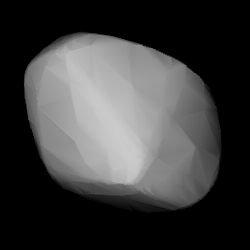 Modelled shape of Bavaria from its lightcurve | |
| Discovery | |
|---|---|
| Discovered by | Johann Palisa |
| Discovery date | 16 November 1890 |
| Designations | |
| (301) Bavaria | |
| Pronunciation | /bəˈvɛəriə/ [1] |
Named after | Bavaria |
| A890 WA; 1928 DH1 1951 FD; 1952 OF | |
| main-belt | |
| Orbital characteristics [2] | |
| Epoch 31 July 2016 (JD 2457600.5) | |
| Uncertainty parameter 0 | |
| Observation arc | 117.42 yr (42888 d) |
| Aphelion | 2.90693 AU (434.871 Gm) |
| Perihelion | 2.54364 AU (380.523 Gm) |
| 2.72528 AU (407.696 Gm) | |
| Eccentricity | 0.066652 |
| 4.50 yr (1643.3 d) | |
| 115.993° | |
| 0° 13m 8.659s / day | |
| Inclination | 4.89466° |
| 142.374° | |
| 125.469° | |
| Physical characteristics | |
| Dimensions | 54.32±3.3 km |
| 12.253 h (0.5105 d) | |
| 0.0546±0.007 | |
| 10.3 | |
301 Bavaria is a carbonaceous background asteroid from the intermediate asteroid belt, approximately 53 kilometers (33 miles) in diameter. [2] It was discovered by Johann Palisa on 16 November 1890 in Vienna.
301 Bavaria is classified as a carbonaceous C-type asteroid. It is spinning with a rotation period of 12.24 h. [3]